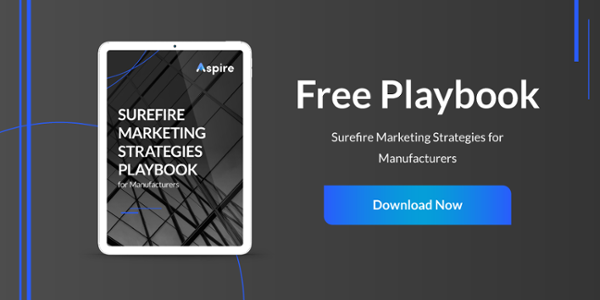- Lead Generation
- Manufacturing
- November 16, 2022
How Manufacturers Can Create Content that Generates Leads

Aaron Marks

“Content is king.” You may have heard this saying one too many times, but it exists for a reason: Because it’s true. Both your customers and Google like content. And since 71% of B2B transactions start with a Google search, it’s important to keep Google happy!
But for manufacturers, the journey toward having great content can be challenging. Many manufacturers have relied on things like brochures, data sheets, and catalogs in the past. And yes – these things are content. But as I’ve explained in the past, the modern buyer demands more.
The key to success with content marketing in B2B manufacturing is to have content for every stage of your funnel. Your buyers want you to help them well before they have decided to buy your product. And if you can earn that trust, you are very likely to then win them as a customer.
But what types of content exactly are essential for manufacturers selling to these discerning B2B customers? And how can you use it to generate leads?
Understanding the Buyer’s Journey for Manufacturers
You can think of your buyer’s process, or your funnel, in three distinct categories: Awareness, Consideration, and Decision.
To generate leads and turn them into customers, manufacturers must have content at every stage of this process. The challenge is that most manufacturers only have strong content for one stage of the funnel – and often, that stage is “Decision.” The problem is that you can’t effectively generate leads or attract interest from prospects with only content like brochures, case studies, and data sheets. That’s because buyers begin their decision process much earlier than this, and if you don’t have the content to help them at that point in their research, you are often going to lose their attention to a competitor who does.
Essential Types of Content for Manufacturers
With the buyer’s journey in mind, let’s have a look at the the types of content that every manufacturer needs to generate leads and turn them into business.
1. Blog Posts (Awareness)
Blogs are an essential part of content marketing today. There are two major reasons for this. First, a blog gives you a hub to share quick, helpful information, often in the Awareness stage. Second, blogs are the single most reliable way to improve your Search Engine Optimization (SEO), which impacts your rankings on Google searches.
HubSpot research finds that business that blog see 126% higher lead growth than non-blogging businesses.
The challenge s that when manufacturers do blog, they often want to talk about the product or feature, rather than a higher level look at the problems your buyers experience and how they can solve them.
So for example, if you manufacture products in the renewable industry, avoid blog posts that are “5 Features of XYZ Company’s Product”. Instead, aim for blogs that are like, “5 Common Renewable Energy Challenges – and How to Solve Them”.
2. Downloadable Lead Magnets (Awareness/Consideration)
If blogs are how you attract people to your website, “lead magnets” are how you turn them into leads. Blogs are publicly viewable by anyone, whereas lead magnets require someone to fill out a form (and thus become a lead) to download. Nearly all the blog posts you create should have a call-to-action that takes visitors to such a form and lead magnet.
Like blogs, lead magnets should be helpful, educational, and not excessively promotional. However, lead magnets should be longer and “deeper dives” that offer considerably more value than any one blog post. By creating such valuable content, you will be able to entice visitors to fill out a form, become a lead, and share their contact information to download it.
Examples of lead magnets that most manufacturers should have would include eBooks, playbooks, guides, and whitepapers.
3. Regular Email Newsletters (Awareness/Consideration)
For a while, email newsletters diminished in popularity, but today, they’re back in style! The advantage of newsletters is that they are a great way to stay top-of-mind with customers and prospects who are still in their buying process.
The key to newsletter success is to send them in a cadenced way. We typically recommend for our clients to start with a monthly newsletter, and then adjust that frequency based on availability and engagement rates to the emails.
4. Webinars (Consideration)
Buyers today have different ways they like to consume information. Some like to read, others like to attend webinars or watch videos. Ensuring you have some diversity in your content mediums is crucial to maximizing the interest you can earn.
Webinars offer a great opportunity to present a double punch: sharing helpful educational content and briefly promoting your own product.
Great webinars still start with the problem and exploring a set of solutions. But if you offer 30-45 minutes of value for your audience, then they will give you 3-5 minutes at the end to be more promotional about your product.
Pro-tip: one of the best ways to get people to register for – and actually attend – your webinar is to partner with an organization to offer continuing education credits.
5. Case Studies (Decision)
People want to buy products that other people trust. This concept comes from a psychological phenomenon called “social proof.”
That’s why I find that case studies are one of the most overlooked types of content in manufacturing. If you have existing customers who have gotten amazing results from your products, why haven’t you written about it? That “social proof” can be the difference between a customer buying from you or a competitor!
Case studies should typically follow a Problem - Solution - Results format. Case studies can also be a bit more promotional, but if it reads like an ad, you will cause your prospect to lose trust in your brand. An amazing case study presents the customer as the hero, and your company/product as the humble sidekick who helped them achieve their goals.
6. Brochures / Data Sheets / Catalogs (Decision)
This is the one area most manufacturers excel at. You know your product is awesome, and you spend most of every day focused on it. So of course it’s not hard to create great collateral for your buyer.
Still, these types of content are critical for manufacturing companies. It’s just important for leaders and marketers to keep in mind that they cannot be the be all, end all to your content. Your buyers demand much more than this, and without content to help them through every step of their research, there’s a high chance they will take their business to someone else.
How Manufacturers Can Use Content to Generate Leads and Win Business
The key to making your content work is to ensure that it’s all connected together. As I touched on above, every single blog post should have a call-to-action that takes people to a related piece of content – ideally a lead magnet where people need to fill out a form to download it.
From there, you should follow up with additional related content to help people through their entire buyer’s journey. One of the best ways to do that is by sending a periodic email – sometimes called “lead nurturing” or “drip nurturing” in the marketing world.
Finally, once these leads engage a fair bit, you will want to have sales reach out and begin to qualify them. Often, this involves some level of lead scoring in your CRM to help identify the most engaged leads.
Get Started Amplifying Your Content Today
When it comes to creating great content, there’s no time like the present. Your buyers already expect it, and your competitors are almost certainly taking actions themselves.
A great way to get started is by completing a content gap audit: which of the above types of essential content does your business already have, and which of them should you get moving to create? One way to think about this is in the context of your funnel. For example, if you have content for the Decision stage, then it might be good to amplify your content that supports Awareness.
Want expert help with that content audit? Get started with a free marketing assessment from Aspire today!
Aaron Marks is the Chief Marketing Officer of Execo. A digital pioneer with nearly two decades of online marketing experience, Aaron has helped organizations ranging from fledgling startups to Fortune 500 enterprises, and global manufacturers to U.S. Presidential campaigns, get the marketing and business results they needed.



0 Comments